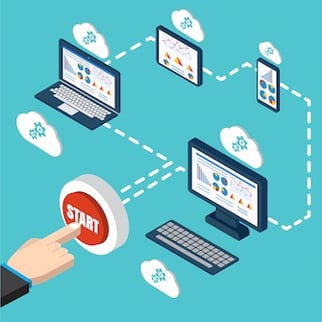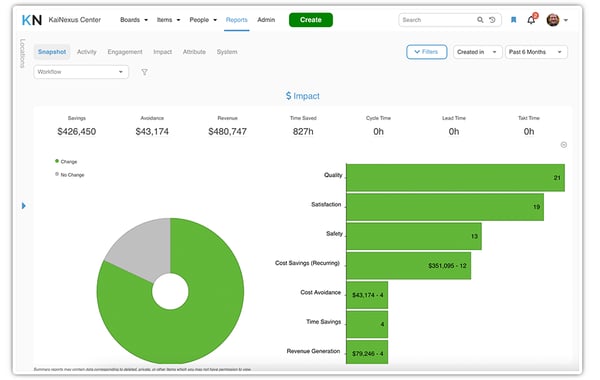 We’ve never met a business leader who is confident that every process in the organization is running perfectly. Every leader wants to find new ways to lower costs, improve customer satisfaction scores, gain more efficiency, and uncover new ways of driving revenue. The difference between organizations that achieve these goals and those that don’t frequently comes down to the structure upon which continuous improvement initiatives are built.
We’ve never met a business leader who is confident that every process in the organization is running perfectly. Every leader wants to find new ways to lower costs, improve customer satisfaction scores, gain more efficiency, and uncover new ways of driving revenue. The difference between organizations that achieve these goals and those that don’t frequently comes down to the structure upon which continuous improvement initiatives are built.
Leaders Get Insight into Improvement Activities
The continuous improvement approach is based on small, daily changes. Usually, these projects don’t require executive-level attention. Problems with workspace organization, inefficient documents, or sloppy data entry aren’t likely to land on the CEO’s desk. But those are precisely the types of issues that continuous improvement is designed to address. With a software platform in place, leaders understand how the team is solving issues like these. There is significant value in knowing what kinds of problems are being reported, who is working to fix them, and how fast those improvement projects are getting done.
Objectives are Consistent and Aligned
Most leaders have a strategic planning process that involves developing a vision for where the organization will be three to five years in the future. To reach key goals, everyone needs to be moving in in the same direction and working toward the same breakthrough objectives. Continuous improvement software sets up the structure for leaders to cascade goals from the C-suite down to the front line. Each employee gets a clear understanding of how their work relates to the strategic goals. Those same objectives drive performance evaluations. When everyone is aligned around the essential goals, decision-making is more natural, and improvement opportunities are apparent.
A Culture of Improvement Evolves
Every organization has a culture, even if it isn’t deliberate. Leaders interested in continuous improvement work to infuse the culture with improvement-centric thinking. They help employees develop the willingness to engage. This isn’t easy because culture can’t be dictated. It is the total of all of the cues people receive about what “normal” behavior is. Continuous improvement software becomes a culture dashboard. Leaders can see which people, units, and departments are effecting positive change. They can also identify where additional training, mentoring, and encouragement are needed.
The Investment Highlights the Importance of Improvement
Most organizations have software to manage every other important function of the business. Sales is run on a CRM, the finance team uses an ERP, and there are often tools running HR. That’s because these core business functions are critical and must be well managed and thoroughly documented. Improvement work is no less critical. When leaders deploy software, they send a message to everyone that this work is essential. An investment in improvement technology gives your team confidence that the organization is willing to put financial resources behind the effort and invest in making individuals successful at seeking positive change.
Employee Recognition is Backed In
Continuous improvement requires people to change their mindset and look at problems in a new way. This can be uncomfortable, especially at first when the culture hasn’t been developed yet. The best way to champion the advantages of daily improvement and to get people thinking about the endless possibilities is to recognize the people who get engaged and take work for change. The most effective process improvement systems include success broadcasting to ensure that each positive result is shared far and wide.
The Impact of Improvement is Measured
Embracing continuous improvement will change the foundations on which your organization operates and impacts every team member’s daily work. That’s why leaders must calculate the impact of improvements to show employees, investors, boards, and others that the effort has been worth it. Improvement management software helps leaders quantify the result against the organization’s key performance indicators like reduced costs, improved customer satisfaction scores, fewer quality defects, and increased revenue.

There is One Version of the Truth
Email and spreadsheets are sometimes used in place of process improvement software with disappointing results. Email is useful for reminders, but it doesn’t give people one place to go for real-time information. Spreadsheets are OK for keeping lists, but they are a passive and easily a broken source for vital data. Improvement software provides everyone with one place to go for the real-time information. Everyone is in sync because they are looking at the same information, not an old email message or Excel file that may be out of date.
Improvement Speeds Up
Continuous improvement software keeps supervisors informed about each project’s progress so that they can coach team members and remove obstacles early. Everyone knows when a task is assigned, or a due date is pending. Without this support, projects can stall and never see the finish line.
A Knowledge Base is Created
Process improvement software serves as a repository for all information about opportunities for improvement and completed projects. Teams can learn from past results, repeat what works, and avoid past mistakes. New employee onboarding happens more quickly, and important knowledge isn’t lost when people change roles or leave the organization.
These are just a few of the many advantages of deploying purpose-built technology to support process improvement. Organizations that adopt software designed to support, document, and align improvement efforts gain big benefits over the competition.
![[WEBINAR] Bottom-Up Improvement Software Demo](https://no-cache.hubspot.com/cta/default/326641/8545f357-84e1-47b2-81e0-f4fa0d3cd893.png)
![[Watch Now] The Why, How, and What of Continuous Improvement](https://no-cache.hubspot.com/cta/default/326641/060c8cc9-44ad-4fd1-ad7b-7b4ab71c7632.png)


Add a Comment